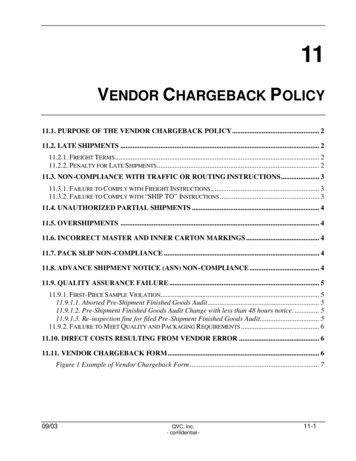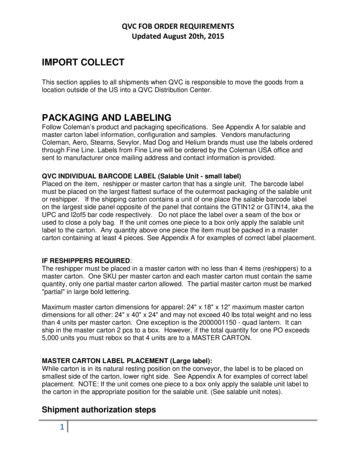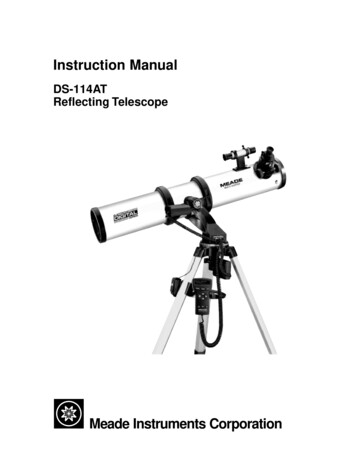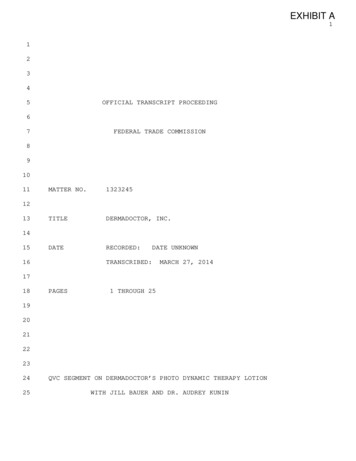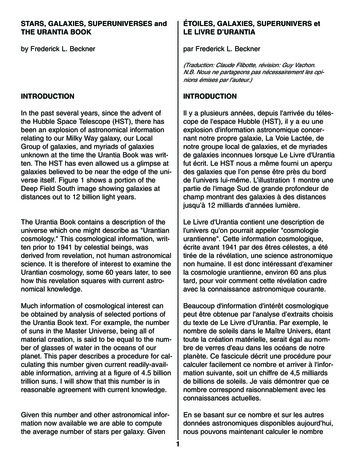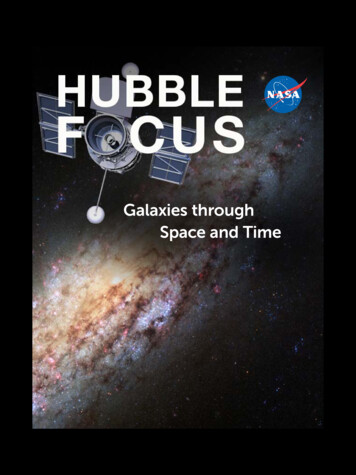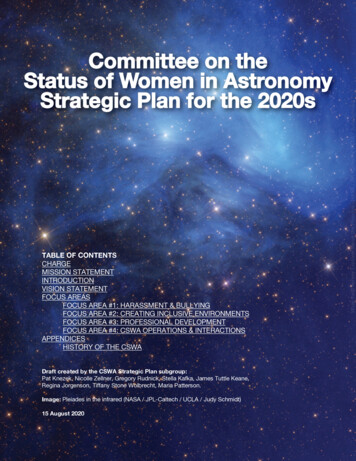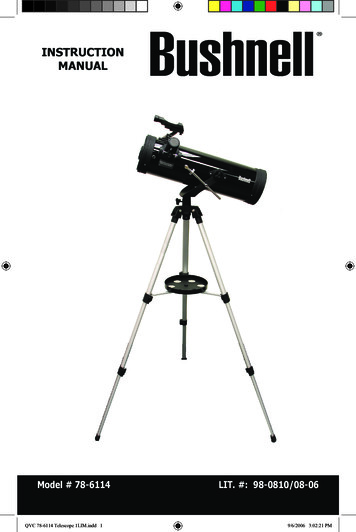
Transcription
INSTRUCTIONMANUALModel # 78-6114QVC 78-6114 Telescope 1LIM.indd 1LIT. #: 98-0810/08-069/6/2006 3:02:21 PM
WHERE DO I START?Your Bushnell telescope can bring the wonders of the universe to your eye. While this manual isintended to assist you in the set-up and basic use of this instrument, it does not cover everything youmight like to know about astronomy. It is recommended you get a very simple star chart and a flashlight with a red bulb or red cellophane over the end. For objects other than stars and constellations,a basic guide to astronomy is a must. Some recommended sources appear on our website at www.bushnell.com. Also on our website will be current events in the sky for suggested viewing. But, someof the standbys that you can see are:The Moon—a wonderful view of our lunar neighbor can be enjoyed with any magnification. Try viewing at different phases of the moon. Lunar highlands, lunar maria (lowlands called “seas” for their darkcoloration), craters, ridges and mountains will astound you.Saturn—even at the lowest power you should be able to see Saturn’s rings and moons. This is one ofthe most satisfying objects in the sky to see simply because it looks like it does in pictures. Imagineseeing what you’ve seen in textbooks or NASA images from your backyard!Jupiter—the largest planet in our solar system is spectacular. Most noted features are its dark stripesor bands both above and below its equator. These are the north and south equatorial belts. Also interesting are Jupiter’s four major moons. Pay close attention to their positions from night to night. Theyappear to be lined up on either side of Jupiter.Mars—The Great Red Planet appears as a reddish-orange disk. Look at different times of the yearand try to catch a glimpse of the white polar ice caps.Venus—just like the moon, Venus changes phases from month to month. At times Venus appearsbrilliantly in the night sky, just as if you were looking at a distant crescent moon.Nebulae—The Great Orion Nebula is a very well known night sky object. This and many others arebrought to you by this telescope.Star Clusters—View millions of stars densely packed in a cluster that resembles a ball.Galaxies—One of the greatest and most interesting galaxies is our neighbor the Andromeda Galaxy.Enjoy this and many others.Other Resources:www.nasa.govwww.space.comQVC 78-6114 Telescope 1LIM.indd 29/6/2006 3:02:21 PM
PARTS DIAGRAMGECHBFLAMLDIPONOTE: Actual product may have improvements that are not shown in this diagramA.B.C.D.Yoke MountFocus KnobFocus TubeObjective Mirror (notshown)E. EyepieceF. Dust Cap (removebefore viewing)QVC 78-6114 Telescope 1LIM.indd 3G. FinderscopeH. Telescope Main BodyI. Tripod LegL. Yoke Locking KnobM. Azimuth LockO. Tripod LegAdjusting ClampP. Accessory Tray9/6/2006 3:02:23 PM
ASSEMBLY DIAGRAMS1.2.3.4.5.CAUTION! Viewing the sun can cause permanent eye damage.Do not view the sun with this telescope or even with the naked eye.QVC 78-6114 Telescope 1LIM.indd 49/6/2006 3:02:25 PM
TELESCOPE ASSEMBLY INSTRUCTIONS1. Your telescope has adjustable (telescoping) legs (Fig. 1).2. Stand tripod and spread legs. Loosen the three leg clamps. Grab tripod head and lift.Extend the tripod legs to the desired height (at equal lengths) and tighten the clampson each leg to hold it in position (Fig. 1). Note: please tighten tripod head bolts afterremoving from box, as some vibration during shipment may have loosened them.3. Attach the accessory tray (P) to the center leg braces on the tripod legs (Fig 2) andinsert accessory tray and bolt through center of tray into braces and tighten bolt.4. Remove telescope main body from the box. Attach telescope main body (H) by aligningthe hole in the telescope saddle with that in the yoke. Screw yoke locking knobs (L)through both holes and tighten the knob.5. Remove the finderscope (G) from the box. Remove the two knurled thumbscrews fromthe telescope main body. Position the finderscope bracket on the telescope main body sothat the holes in the base of the bracket line up with the exposed bolts in the telescopemain body. Replace the two-knurled thumbscrews and tighten securely (Fig. 3).6. Insert eyepiece (E) into focus tube (C). Secure by tightening small retaining screw.NOTE: In all astronomical telescopes, the image appears upside down. To use thetelescope for terrestrial view and to correct the mirrored image, insert the erectingeyepiece in between the focus tube (C) and the eyepiece (E). We recommend the useof the low magnification eyepiece when the telescope is used for terrestrial viewing.Reflectors (mirrors) are used mainly for astronomical purposes.The telescope is now fully assembled and ready for use.7. To use the Barlow, insert Barlow (Fig. 5) into the focus tube. Secure by tightening smallretaining screw. Insert eyepiece into open end of Barlow and secure.8. To use the erecting lens, insert erecting lens (Fig. 5) into the focus tube. Secure bytightening small retaining screw. Insert eyepiece into the open end of the erecting lensand secure. This will allow you to view objects naturally on land—not upside down orbackwards.TO USE THE FINDERSCOPEThe finderscope is a small wide field of view telescope mounted alongside the maintelescope and is used to search for the target and aim the main telescope at it. But beforeyou can use the finderscope, you will need to line it up with the telescope. This procedurewill become easier with practice.1. Install the lowest power eyepiece (25mm) into the eyepiece tube. Pick out an easilyrecognized, unmoving object no closer than a thousand yards away. Aim your telescopetoward your object until its image is centered in the eyepiece. Lock all the knobs on themount so the telescope will not move.2. Look through the finderscope. If the object you lined up in the telescope is not visible,adjust the two adjustment screws and move the finderscope around until you see it.3. Recheck your telescope to make certain it is still on target. If it moved, realign it andadjust your finderscope. If it hasn’t, you’re all set. Your finderscope is now operational.QVC 78-6114 Telescope 1LIM.indd 59/6/2006 3:02:26 PM
FINDING OBJECTS1. Loosen the altitude locks on the sides of the telescope tube and the silver azimuth lock on thebase of the altazimuth mount, then move the telescope in the desired direction.2. Look through the finderscope and pan the telescope until the object appears in the field of view.Once it's in the field of view, tighten the altitude and azimuth locks.FOCUSING1. Once you have found an object in the telescope, turn the focus knob until the image is sharp.2. To focus on an object that is nearer than your current target, turn the focusing knob toward theeyepiece (i.e., so that the focus tube moves away from the front of the telescope). For moredistant objects, turn the focus knob in the opposite direction.3. To achieve a truly sharp focus, never look through glass windows or across objects that produceheat waves, such as asphalt parking lots.MAGNIFICATION1. The magnification (or power) of a telescope varies depending upon the focal length of theeyepiece being used and the focal length of the telescope.2. To calculate magnification, use the following formula, in which FL focal length:Magnification FL (telescope) in mmFL (eyepiece)TECHNICAL SPECIFICATIONSObjective Diameter:Focal Length:Eyepieces:114mm (4.5”)500mmH20mm (Low Power)H12.5mm (High Power)Erecting Eyepiece:Barlow:Maximum Magnification:Accessories:1.5X3X120XFinderscope, moonmap, astronomy CDEYE LENS CHART & THEORETICAL POWER LIMITSH12.5mm Eye Lens Power:H20mm Eye Lens Power:40X25XNOTE: Magnification is calculated magnification.Low power is recommended for most viewing conditions.QVC 78-6114 Telescope 1LIM.indd 69/6/2006 3:02:26 PM
ENJOYING YOUR NEW TELESCOPE1. First determine your targeted object. Any bright object in the night sky is a good starting pointOne of the favorite starting points in astronomy is the moon. This is an object sure to please anybudding astronomer or experienced veteran. When you have developed proficiency at this level,other objects become good targets. Saturn, Mars, Jupiter, and Venus are good second stepsto take.2. The first thing you need to do after assembling the telescope as planned is center the desired objectin the finderscope. Provided you did a reasonable job aligning the finderscope, a quicklook through the main telescope tube at low power should reveal the same image. With the lowestpower eyepiece (the one with the largest number printed on it) you should be able to focus thesame image that you saw through the finderscope. Avoid the temptation to move directly to thehighest power. The low power eyepiece will give you a wider field of view, and brighter image—thusmaking it very easy to find your target object. At this point with a focused image in both scopes,you’ve passed the first obstacle. If you don’t see an image after attempting to focus it in, youmight consider aligning your finderscope again. Once you pass this step, you’ll will enjoy the timespent ensuring a good alignment. Every object you center in the finderscope will be easily found inthe main telescope tube, which is important for continuing your exploration of the night sky.3. The low power eyepieces are perfect for viewing the full moon, planets, star clusters, nebulae, andeven constellations. These should build your foundation. However, for more detail, try bumpingup in magnification to higher power eyepieces on some of these objects. During calm and crispnights, the light/dark separation line on the moon (called the “Terminator”) is marvelous at highpower. You can see mountains, ridges and craters jump out at you due to the highlights. Similarly,you can move up to higher magnifications on the planets and nebulae. Star clusters and individualstars are best viewed through the low power no matter what.4.The recurring astronomical theater we call the night sky is an ever-changing billboard. In otherwords, the same movie does not play all the time. Rather, the positions of the stars change notonly hourly as they seem to rise and set, but also throughout the year. As the earth orbits thesun, our perspective on the stars changes on a yearly cycle about that orbit. The reason thesky seems to move daily just as the sun and the moon "move across our sky is that the earthis rotating about its axis. As a result you may notice that after a few minutes or a few secondsdepending on what power your are viewing at, the objects in your telescope will move. Athigher magnifications especially, you will notice that the moon or Jupiter will :race: right out ofthe field of view. To compensate, just move your telescope to "track" it in the necessary path.QVC 78-6114 Telescope 1LIM.indd 79/6/2006 3:02:26 PM
HELPFUL HINTS1. Your telescope is a very sensitive instrument. For best results andfewer vibrations set your telescope up on a level location on theground rather than your concrete driveway or your wooden deck. Thiswill provide a more stable foundation for viewing, especially if you’vedrawn a crowd with your new telescope.2. If possible, view from a location that has relatively few lights. This willallow you to see much fainter objects. You’d be surprised how muchmore you’ll see from your local lake or park when compared to abackyard in the city.3. Using your telescope out a window is NEVER recommended.4. View objects that are high in the sky if possible. Waiting until theobject rises well above the horizon will provide a brighter and crisperimage. Objects on the horizon are viewed through several layers ofearth’s atmosphere. Ever wonder why the moon appears orange as itsets on the horizon? It’s because you are looking through a considerable more amount of atmosphere than you would directly overhead.(Note: If objects high in the sky are distorted or wavy, you are probablyviewing on a very humid night.) During nights of unstable atmosphere,viewing through a telescope can be frustrating if not impossible.Astronomers refer to crisp, clear nights as nights of “good seeing.”Customer Service (800) 423-3537 2006 Bushnell Outdoor Productswww.bushnell.comQVC 78-6114 Telescope 1LIM.indd 89/6/2006 3:02:27 PM
TELESCOPE LIFETIME LIMITED WARRANTYYour Bushnell telescope is warranted to be free of defects in materials and workmanship for the lifetime ofthe original owner. The Lifetime Limited Warranty is an expression of our confidence in the materials andmechanical workmanship of our products and is your assurance of a lifetime of dependable service.If your telescope contains electrical components, these components are warranted to be free of defects inmaterials and workmanship for two years after the date of purchase.In the event of a defect under this warranty, we will, at our option, repair or replace the product, providedthat you return the product postage prepaid. This warranty does not cover damages caused by misuse,improper handling, installation, or maintenance provided by someone other than a Bushnell AuthorizedService Department.Any return made under this warranty must be accompanied by the items listed below:1) A check/money order in the amount of 15.00 to coverthe cost of postage and handling2) Name and address for product return3) An explanation of the defect4) Proof of Date Purchased5) Product should be well packed in a sturdy outside shipping carton, to preventdamage in transit, with return postage prepaid to the address listed below:IN U.S.A. Send To:Bushnell Outdoor ProductsAttn.: Repairs8500 Marshall DriveLenexa, Kansas 66214IN CANADA Send To:Bushnell Outdoor ProductsAttn.: Repairs25A East Pearce Street, Unit 1Richmond Hill, Ontario L4B 2M9For products purchased outside the United States or Canada please contact your local dealer for applicablewarranty information. In Europe you may also contact Bushnell at:BUSHNELL Outdoor Products GmbhEuropean Service CentreMORSESTRASSE 4D- 50769 KÖLNGERMANYTél: 49 (0) 221 709 939 3Fax: 49 (0) 221 709 939 8This warranty gives you specific legal rights.You may have other rights which vary from country to country. 2006 Bushnell Outdoor ProductsQVC 78-6114 Telescope 1LIM.indd 99/6/2006 3:02:27 PM
QVC 78-6114 Telescope 1LIM.indd 3 9/6/2006 3:02:23 PM. 1. 3. 4. 5. DIAGRAMS ASSEMBLY 2.! N O I T U A C. e g a m a d e y e t n e n a m r e p e s u a c n a c n u s e h t g n i w e i V. e y e d e k a n e h t h t i w n e v e or e p o c s e l e t s i h t h t i w n u s e h t w e i v t o n o D QVC

